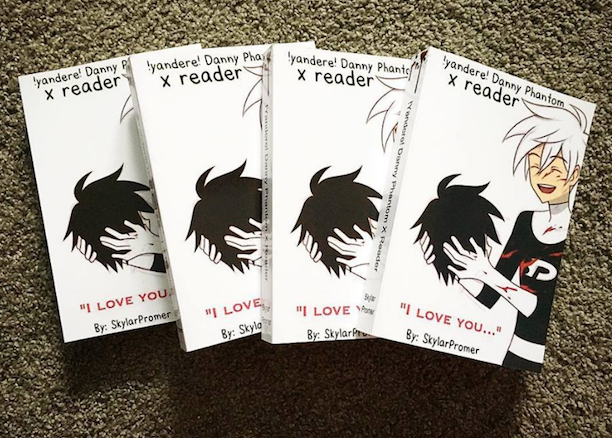Guide to writing | Fan fiction allows writers to adapt characters in their own original stories

Promer has written her own fan fiction and has posted it onto the internet for all to read. She also has printed physical copies, seen above.
Fan fiction is a common word nowadays, mostly used over the Internet, but what does fan fiction mean?
Well, it is basically what it sounds like, fiction written by fans of a certain book, movie, TV show, etc. These works are usually written for the enjoyment of the author as well as fellow fans who might come across the writing at one time or another in their journey into what is called the fandom (fanatic domain).
Fan fiction can be a wide range of things and doesn’t always have to have a romantic relationship behind it, leaving plenty of room for friendships, enemy angst, sad tales and reader inserts. A reader insert is when an author chooses not to give the main character a name, instead, replacing the name with something the reader can replace with their own name and/or another character’s name while reading using other words such as Y/N and Reader. Most fan fiction readers can see the word “Y/N” and automatically replace it with their own name or their default character’s name as they read.
Newcomers to fan fiction may have a bit of trouble at first reading over the abbreviations fan fiction writers commonly use such as Y/N, though not all fan fiction has to be writer inserts. Many other writings can be using just the characters of the show or book interacting, or it can be the characters interacting with the author’s own original character. Usually, these characters are given their own backstories that may or may not interact with some of the main characters.
All in all, a fan fiction can go in many ways and can be found across many sites on the Internet including but not limited to Wattpad, Archive of our own, Deviantart and Fanfiction.net.
These days, there have been plenty of people spending their days reading and enjoying fan fiction of their choosing. But then again, there has been an increase of people hating on these works, claiming they are not “real writing.”
What defines “real writing”? Whether it’s popular or not? If it’s published writing or not? If it’s making money or free to read? While there is no real definition, I like to think that “real writing” is any writing, fan fiction or not, that anyone has put real effort and enjoyment into writing. The quality of fan fiction, while it does help to gain readers attention with good grammar and proper spelling, is not mandatory.
That being said, fan fiction is not reserved only for experienced writers. In fact, fan fiction welcomes new writers to try out their skills, allowing them their first taste of what it is the be a writer.
I, myself began as a fan fiction writer not all that long ago. I am not ashamed of my writing, nor will I ever be. My creation is up on the Internet for everyone to see. I have put my writing into a physical book form for myself to hold in my hands. This writing took time. It took effort. I put all my love for this certain character of one of my favorite TV shows and wrote it down, creating my own story. Doing so, publishing it online for people to read and give me feedback on, I could and can still see myself growing as a writer. Even as I write this very paper, I am growing as a writer.
Fan fiction is something out there for everyone. It’s free for everyone to do, to write and share their own creations with people who might enjoy it in the same way the author has.
Sharing your writing with people is horrifying. Sharing it with complete strangers over the Internet is even more so. Yet fan fiction writers have been doing it for years, being brave authors and putting their work out there for the world to enjoy.
Many of these authors will receive hate comments and/or messages at some point in this process, but they learn to deal with it and most of the time, with the help of their readers and other authors, will receive defense over their works.
I finished writing my fan fiction story three years ago, and I still find myself defending it. I see my readers defending it as well.
Fan fiction has allowed me to be more comfortable in my writing style and just writing in general. It’s no secret that writing is hard to do, but fan fiction allows a writer to write about something they are familiar with, giving them the opportunity to change it up as they see fit and in turn creating a story all their own.
Some fan fictions have been published as “actual books” and even turned into movies. Many may recognize these titles: “Fifty Shades of Grey” and “After.” “Fifty Shades of Grey” was originally a Twilight fan fiction until the author was offered a publication as long as she changed the names from “Edward” and “Bella.” The new “After” book and movie was a “One Direction” Harry Stiles fan fiction before the author was also offered to be published.
Though many might agree those aren’t the best fan fiction in existence, there is no requirement for fan fiction. That is the greatest part about it, that there are no rules, no regulations. It’s a blank canvas inviting aspiring writers to come fill the void with beautiful words that will eventually tell a story. That is the true beauty in writing fan fiction.
So as long as the writer has a story in mind and words to fill a blank page, what are they waiting for? Fan fiction is a great place to test writing skills, practice fitting a story together, attempt the great feat of what it is to be a writer and actually write.
With no fee or great quest, fan fiction is open to everyone no matter their interest. There is almost at least one fan fiction story for each and every one of TV shows and books out there, and if there isn’t, why not give fan fiction a try and write it? The only limit is the writer’s own mind.
A Short Guide To Reading Fan Fiction:
Y/N = Your name.
Fan fiction writers will either use “Y/N” or “Reader” to indicate where to add in a name while reading.
F/N = First name. Depending on the context, could also mean Friend’s name.
Most writers I’ve come across will use this as a signal to insert a Friend’s name into the story. Though be cautious when adding a friend’s name, the outcome for them usually isn’t too great.
L/N = Last name. Sometimes writers find it necessary when introducing main characters to the reader by using the reader’s last name.
N/N = Nickname. When other characters are speaking to the reader, they sometimes find it necessary to call the reader by their nickname. This usually happens when the reader and the character in the story have “known” each other for a while or are in the start of some sort of relationship.
F/C = Favorite color. Instead of choosing a specific color of clothing and/or room scenery, the writer will simply add F/C, indicating the reader to insert their favorite color to imagine the surrounding and/or clothing in that color.
F/F = Favorite food. Writers will use this mostly when a main character is asking the reader what kind of food they want and/or handing them said favorite food in the story.
OC = Original character. Some writers like to use their own characters in their stories instead of reader inserts. In these stories, they will introduce the reader to their OC, most often leading into a back story for said character.
OOC = Too unlike the actual character. New writers will use this term usually when writing for a character they normally wouldn’t and/or haven’t written for before. Most of the time they apologize for the actions of the character, hoping the character didn’t seem too “OOC.”
Main/minor character X OC, Main/minor character X Main/minor character, Main/minor character x Reader. = The story revolves around the relationship of these characters. This is usually stated at the beginning of the story. It is most likely in the title of the story somewhere or at least hints to it in some way. These phrases either signal to the story being about the relationship of the main character and a writer’s original character, two main/minor characters, and/or between the main/minor character and the reader.
Keep in mind these relationships don’t always have to be romantic. There are plenty of stories out there about sibling relationships as well as friendships.
SFW and NSFW = Safe for work and not safe for work. “Safe for work” stories as generally PG-13 and are “safe” for anyone to read. “Not safe for work” stories range from PG-13 to and R rating depending on the reason for the NSFW warning.









You must be logged in to post a comment Login